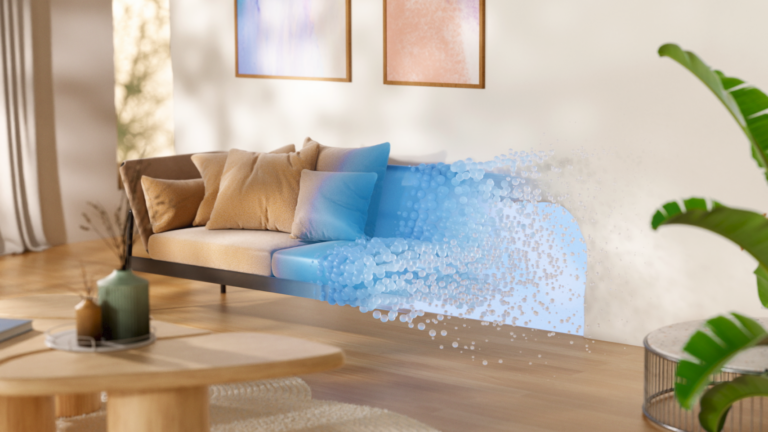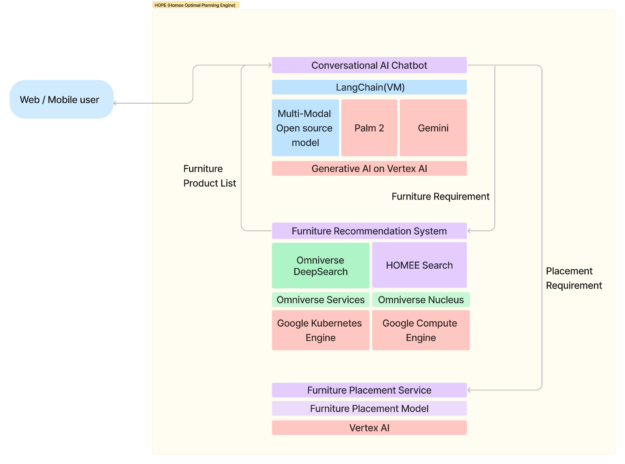
HOMEE AI, an NVIDIA Inception member based in Taiwan, has developed an “AI-as-a-service” spatial planning solution to disrupt the $650B global home decor…
HOMEE AI, an NVIDIA Inception member based in Taiwan, has developed an “AI-as-a-service” spatial planning solution to disrupt the $650B global home decor market. They’re helping furniture makers and home designers find new business opportunities in the era of industrial digitalization.
Using NVIDIA Omniverse, the HOMEE AI engineering team developed an enterprise-ready service to deliver physically accurate 3D furniture assets to an end-user’s home.
“Today’s home furnishing industry is stuck in the ’80s,” said Kenny Du, founder and CEO of HOMEE AI. “Our goal is to accelerate the digital transformation for the home furnishing industry and make furnishing homes much easier and more fun.”
Universal Scene Description (OpenUSD), the framework and ecosystem behind Omniverse, allows HOMEE AI to connect diverse customer data sources and unlock new possibilities for their spatial AI solution.
Specifically, the HOMEE Optimal Planning Engine (H.O.P.E.) uses USD metadata to recommend ideal furniture assets and optimal placement. NVIDIA RTX Technology powers the solution on Omniverse, enabling real-time rendering and unparalleled AI performance.
A changing landscape for home furnishing and interior design
Consumers increasingly desire the ability to try out products before making a purchase decision, a demand that has historically proven challenging in the realm of home furniture and design.
Today’s tools are limited in providing realistic, immersive experiences with fast rendering and intuitive user experiences. The process of measuring and planning a space is also painful and time-consuming for customers. One estimate from HOMEE AI puts the average at 20 days to come up with designs.
Furthermore, the cost per sale (CPS) of furniture items is significant. If you want to sell a sofa, for example, HOMEE AI found it takes them an average of $140 to find the customer.
To meet consumer expectations and lower costs, furniture companies are turning to industrial digitalization technologies like digital twins and investing more in e-commerce than ever before. Many leading furniture providers are digitalizing their product catalogs by creating extensive libraries of photorealistic 3D models, which they are leveraging for their own e-commerce sites and augmented reality visualization apps.
But how does an industry that thrives on the creativity and personal style of its customers ensure that products stand out in a crowded and impersonal online marketplace?
Bringing photorealistic furniture into consumer homes
H.O.P.E. delivers a cost-effective sales channel for global furniture brands and enables consumers to visualize furniture in their home space through photorealistic OpenUSD-based 3D models.
The technology streamlines the digitalization efforts of home decor companies, while simultaneously empowering consumers to try products in their virtual home before making a purchase decision.
Today, their platform is gaining interest and adoption by furniture manufacturers and suppliers who can now connect their asset libraries to consumer homes and accelerate the purchasing process.
Video 1. HOMEE AI: The World’s First Spatial Planning AI
Increasing flexibility and scale
H.O.P.E. was developed on Omniverse, a platform for building OpenUSD-based applications for industrial digitalization. Using Omniverse enabled HOMEE AI to extend its reach and position the platform to scale through its foundational technologies like Nucleus, the ability to integrate powerful APIs like NVIDIA Isaac Sim, and the primary data model of OpenUSD. OpenUSD is an extensible interchange maintained by the Alliance for OpenUSD for collaboratively constructing and aggregating 3D scenes.
To build a flexible and scalable solution, HOMEE AI needed an interchange that would enable it to connect diverse customer data to virtual worlds at scale. They had no idea just how powerful USD could be before developing their solution on NVIDIA Omniverse, which is built atop OpenUSD as the primary data model for describing and composing scenes.
They quickly realized that it was much more than a 3D file format, and could add flexibility and scale to workflows that would transform customer experiences. It supports a wide variety of properties to define and render objects while making scene structuring and editing more efficient and collaborative with sparse, non-destructive authoring.
USD’s non-destructive layering enables users to easily adjust properties like geometry, pose, and lighting without affecting the entire scene, a feature HOMEE AI leverages by referencing customer 3D models and iterating on their properties.
“Connecting to USD opens up a new world of possibilities for us,” said HOMEE AI CTO Gene Chang. “It enables our customers to seamlessly connect their data to a secure, cloud environment where they can deliver showroom experiences to consumers in their own homes.”
With just a few clicks in the H.O.P.E mobile app, a user’s physical room becomes a virtual scene in Omniverse, where they can add and move around 3D furniture assets, connected directly to the retailer’s marketplace. This is made possible through OpenUSD.
 Figure 1. HOMEE AI’s H.O.P.E. inference architecture
Figure 1. HOMEE AI’s H.O.P.E. inference architecture
HOMEE AI uses OpenUSD to cater to the unique needs of customers who use different 3D content creation tools, enabling the seamless integration of 3D furniture models from various sources. By partnering with furniture industry players, HOMEE AI connects their 3D models to the Omniverse Nucleus database or receives them directly, converting and optimizing them into USD for a diverse furniture catalog.
Omniverse DeepSearch, a feature of Nucleus, allows HOMEE AI to enhance its search capabilities with AI, helping you effortlessly discover the perfect 3D assets. This powerful tool streamlines the design process, making it easier to find and integrate the right furniture pieces into virtual spaces.
Accelerating AI innovation
Building with USD on Omniverse also positions HOMEE AI to continue integrating cutting-edge AI capabilities. AI functionalities such as NVIDIA Deep Learning Super Sampling (DLSS) and Omniverse DeepSearch are native to the Omniverse platform and can be integrated into end-user solutions that you build on Omniverse.
NVIDIA Isaac Sim is an extensible robotics simulator in Omniverse that delivers scalable, photorealistic, and physically accurate virtual environments for building high-fidelity simulations. It was also critical for HOMEE AI in training their spatial AI solution. By simulating scenarios, Isaac Sim provides the AI model with a rich learning environment, ensuring that the model can handle a variety of spatial planning challenges.
 Figure 2. Training methodology of HOMEE AI’s 3D planning engine
Figure 2. Training methodology of HOMEE AI’s 3D planning engine
In addition, USD’s ability to aggregate rich data, including spatial information, creates an ideal environment for AI models to analyze and make recommendations. HOMEE AI’s spatial AI uses USD metadata to recommend the ideal furniture asset and its optimal placement in a room.
As OpenUSD continues to evolve, HOMEE AI looks forward to expanding its 3D capabilities and delivering groundbreaking experiences for its partners, using the growing ecosystem of technologies and opportunities.
“In the future, we believe everyone will use USD,” says Chang. “With USD as a core part of our offering, we know that we will continue to be at the forefront of innovation in 3D and digital twin workflows.”
Explore the latest in generative AI and OpenUSD at NVIDIA GTC 2024
HOMEE AI’s generative AI and OpenUSD solution is helping accelerate digital transformation in the global design industry. Across other industries, developers and enterprises are racing to adopt OpenUSD and unlock the potential of generative AI to power their 3D workflows.
At NVIDIA GTC, HOMEE AI and other OpenUSD experts, developers, and business leaders are coming together to share groundbreaking innovations in industrial digitalization. Don’t miss their session, 3D and Gen AI at Home: Building an Application for the Global Design Industry.
Be sure to also attend OpenUSD Day on March 19 to see how startups and industry leaders are building generative AI-enabled 3D pipelines and tools using USD.
Source:: NVIDIA